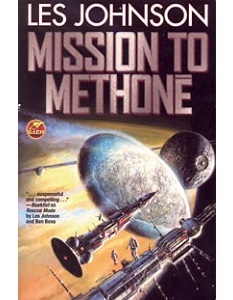Reviewing a science fiction novel is arguably more difficult than for a factual book. The intended audience for an engineering text, legal tome or coffee-table glossy is relatively clear, but the audience for a novel depends, to a large extent, on personal preference and how much the reader wants to be ‘stretched’ by the reading experience.
That said, this is clearly more of a ‘space opera’ than what science fiction aficionados call ‘hard SF’. Informed by his science background, Johnson writes straightforwardly with little superfluous waffle or artistic pretension. In fact, the book is reminiscent of a space fiction series of the 1950s/60s written for children by the little-known British author Hugh Walters and its similarly alliterated titles, such as Mission to Mercury and Spaceship to Saturn. Johnson himself acknowledges the similar ‘Perry Rhodan’ series as an inspiration.
Mission to Methone (described as “a tiny egg-shaped moon of the planet Saturn”) is set in 2065 and has a space scientist as its ‘hero’. He discovers that one of the asteroids he’s surveying for mining is actually a derelict spaceship, a relic of a war between “alien civilizations that have very different ideas about what should be done about emerging civilizations like our own”.
The story moves with pace from the beginning and the short chapters typically end with a pithy remark or wake-up statement that moves the reader forward. However, it slows somewhat towards the end with the introduction of new characters and seems repetitious in its reminders of what has gone before. Then, six pages from the end, we get a lecture on gravitational lensing! This would be better left to the existing ‘Afterword’, which explains some of the physics behind the book in an informative and accessible way. On balance, though, an easy read for a budding space fan.











